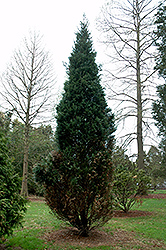It's all about ...
plants

Columnar Lawson Falsecypress
Chamaecyparis lawsoniana 'Columnaris'
Height: 40 feet
Spread: 15 feet
Sunlight:
![]()
![]()
Hardiness Zone: 6a
Other Names: Oregon Cedar, Port Orford Cedar
Description:
A rigidly dense and upright small tree with a tightly columnar habit of growth; lends an air of formality to the landscape; best used in areas of higher humidity
Ornamental Features
Columnar Lawson Falsecypress is primarily valued in the landscape for its rigidly columnar form. It has dark green evergreen foliage. The scale-like sprays of foliage remain dark green throughout the winter. The shaggy antique red bark adds an interesting dimension to the landscape.
Landscape Attributes
Columnar Lawson Falsecypress is a dense multi-stemmed evergreen tree with a narrowly upright and columnar growth habit. Its relatively fine texture sets it apart from other landscape plants with less refined foliage.
This is a relatively low maintenance tree. When pruning is necessary, it is recommended to only trim back the new growth of the current season, other than to remove any dieback. It has no significant negative characteristics.
Columnar Lawson Falsecypress is recommended for the following landscape applications;
- Accent
- Vertical Accent
Planting & Growing
Columnar Lawson Falsecypress will grow to be about 40 feet tall at maturity, with a spread of 15 feet. It has a low canopy with a typical clearance of 3 feet from the ground, and should not be planted underneath power lines. It grows at a medium rate, and under ideal conditions can be expected to live for 70 years or more.
This tree does best in full sun to partial shade. It prefers to grow in average to moist conditions, and shouldn't be allowed to dry out. It is not particular as to soil type, but has a definite preference for acidic soils. It is somewhat tolerant of urban pollution. Consider applying a thick mulch around the root zone in winter to protect it in exposed locations or colder microclimates. This is a selection of a native North American species.
This plant is not reliably hardy in our region, and certain restrictions may apply; contact the store for more information.
